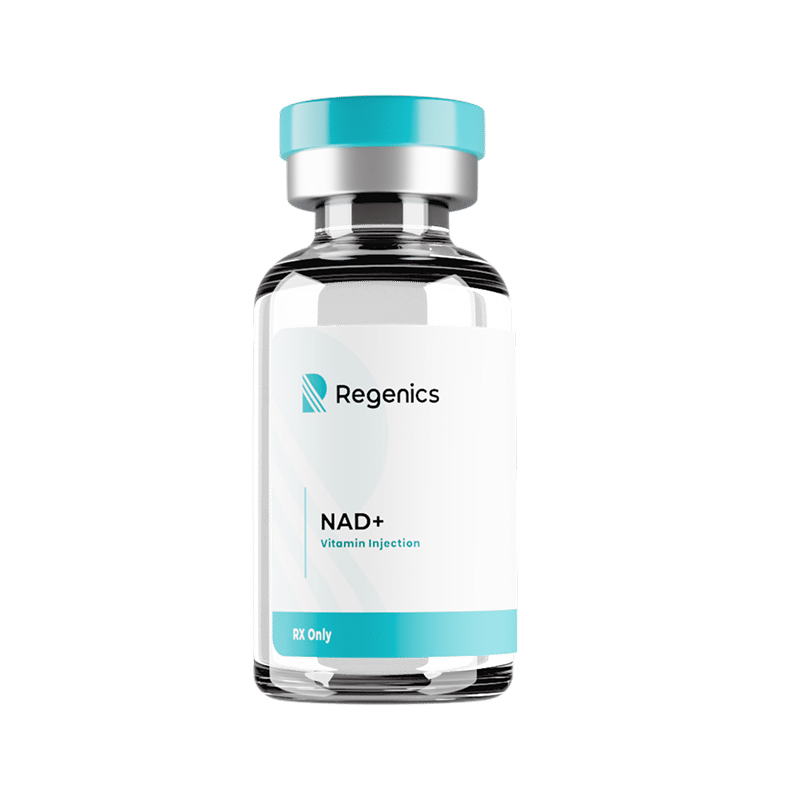NAD+ Injections
- PROMOTES DNA REPAIR
- IMPROVES COGNITIVE ABILITIES
- INCREASES ATHLETIC PERFORMANCE
- SUPPORTS WEIGHT LOSS
- DECREASES FATIGUE
- COMPOUNDED IN USA
- FOR IM OR SUBCUTANEOUS USE ONLY
- 503A APPROVED FOR HUMAN CONSUMPTION
1000MG = 10 Week Supply
2000mg = 20 Week Supply
*NAD+ IV Infusions available in office
$299.00 – $399.00 — or from $269.10 – $359.10 every 10 weeks

What is NAD+?
How NAD+ works

Activated Longevity Proteins
It activates sirtuins, proteins that regulate cellular health, repair DNA, and promote anti-aging effects.

Boosted Cellular Energy
NAD+ is a coenzyme that fuels mitochondria, the energy powerhouses of cells, to produce ATP and sustain physical and mental performance.

Enhanced Cellular Repair
NAD+ supports the repair of damaged DNA and combats oxidative stress, ensuring optimal cell function and resilience.
How to take NAD+
Always follow the instructions of your provider when taking NAD+. Regenics offers a 1,000mg vial or a 2,000mg vial. Typically, NAD+ injections are administered twice a week.
If you miss a dose, take the missed dose as soon as possible.
Common side effects of NAD+
NAD+ supplementation is generally well-tolerated, but some people may experience mild side effects. Common side effects include:
- Flushing or Warmth: A temporary sensation of heat or redness, especially with high doses or IV administration.
- Headaches: Occasionally reported, likely due to increased cellular activity or detoxification processes.
- Fatigue or Insomnia: Some individuals may experience temporary fatigue or difficulty sleeping as the body adjusts.
These effects are typically short-lived, and consulting a healthcare provider can help adjust dosing or administration methods to minimize discomfort.

See what others like you are saying...




These customers’ results have not been independently verified. Individual results will vary.
Frequently asked questions about compounded NAD+
Who should take NAD+?
How long does NAD+ therapy take to show results?
Is NAD+ therapy safe?
What do studies show?
Nicotinamide adenine dinucleotide (NAD+) is a vital coenzyme involved in numerous cellular processes, including energy metabolism and DNA repair. Recent studies have explored its potential therapeutic benefits. Here are summaries of ten positive studies on NAD+:
1. Neuroprotection in Parkinson’s Disease: Supplementation with nicotinamide riboside (NR), a precursor to NAD+, increased brain NAD+ levels and showed neuroprotective effects in Parkinson’s disease models. (1)
2. Reversal of NAD+ Deficiency in Arthritis: NAD+ boosters like NR and nicotinamide restored NAD+ levels in immune cells of arthritis patients, suggesting potential therapeutic benefits. (2)
3. Protection Against Neurodegeneration: NR supplementation protected neurons linked to Parkinson’s in mice, preventing the development of Parkinson’s-like behaviors. (3)
4. Cardiovascular and Renal Health: NAD+ enhancers have shown promise as therapeutic agents in the cardiorenal axis, potentially benefiting heart and kidney health. (Oxford Academic)
5. Improved Glucose and Lipid Metabolism: NAD+ precursor supplementation positively affected glucose and lipid metabolism in humans, indicating potential benefits for metabolic health. (5)
6. Protection After Heart Attack: NAD+ supplementation protected the heart and brain from damage following a heart attack, suggesting a role in recovery. (6)
7. Enhancement of Brain NAD+ Levels: A study is evaluating whether nicotinamide riboside supplementation can affect NAD+ levels in the brain, with implications for cognitive health. (7)
8. Improvement in Withdrawal Symptoms: Intravenous NAD+ significantly improved withdrawal symptoms associated with substance dependence, indicating potential in addiction therapy. (8)
9. Anti-Aging Effects: Research suggests that NAD+ boosters or supplementation can result in health benefits and delayed signs of aging, though more research is needed. (9)
10. Increased NAD+ Levels in Healthy Adults: Qualia NAD+ significantly increased NAD+ levels in healthy adults compared to placebo, indicating its efficacy as a supplement. (10)
About your NAD+ order
Expedited delivery
Your medication will ship discreetly to your door.
Everything You Need
Your package includes all supplies, medication, and dosing instructions.
Connect with a provider
Regenics providers are on hand with for any questions or concerns you may have.
Boost your learning on anti-aging
Unlocking the Power of NAD+: The Science Behind Cellular Energy and Longevity
Explore more anti-aging treatments

Glutathione
$24.90/week
- Crucial antioxidant and detoxifying agent in cells
- Could neutralize free radicals thereby preventing cellular damage

Hard Mints by Hims
Resveratrol
$0.85/serving
Promotes heart health, combats aging, and boosts cellular repair for vibrant, long-lasting wellness.


